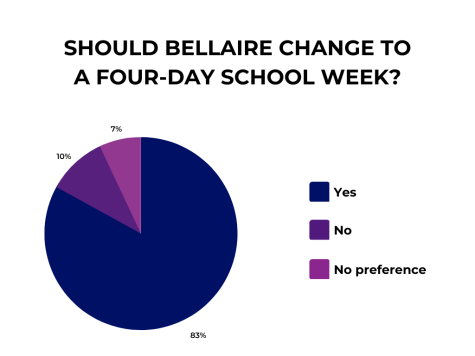[EDITORIAL] Give us a break
Why a four-day instructional week would benefit HISD
Crosby ISD became the largest school district in Texas to adopt a four-day instructional week on Feb. 28. There are now an estimated 43 districts in Texas aiming to implement the schedule change in the 2023-2024 school year.
We encourage HISD officials to consider looking into the four-day work week as it will ultimately give a much needed break for all staff and students.
A four-day school week takes off one day of the week, usually Friday, and as a result the other days would be longer. For Crosby, students would spend 20-25 min more time in school every day, but would lose out on around 58 hours of school yearly.
Due to a shortage of instructors, districts are making the switch to a four-day school week to increase teacher retention. And who wouldn’t want to work four-days a week? A four-day instructional period would give teachers and administrators significantly more free time. Teachers would have one Friday every month as a planning day, decreasing their workload on the weekend and also giving them more time to have their own life outside of grading papers and planning course work.
More “off time” wouldn’t just help teachers with additional time to rest, but students as well. The four-day week changes sleep patterns, with elementary students saying they got more sleep. An extra day to rest also works wonders on the mental and physical health of students in school.
Good sleep is an important part of a healthy life. It leads to healthy brain function leading to more participation and focus in class. Lack of sleep can raise your risk for serious health problems like heart disease and diabetes, as well as increase stress and worsen your mood.

Furthermore, students overburdened by homework would have more time for extracurricular activities. This would give them time for family and other interests that positively impact their life, such as working, participating in internships, volunteering, reading, spending time with friends, and/or traveling.
Another major component of the four-day instructional week is the cost savings; not just for schools, but districts too, as they would not have to pay for transportation, food service, and overhead associated with a fifth day of school. With more money, schools can plan more fun for the students like field trips and events.
The four-day week is not only limited to schools. A 32-hour workday bill, introduced by Rep. Mark Takano (D-CA), proposes amending the Fair Labor Standards Act to shorten the standard workweek by eight hours. Shorter work weeks lead to increased productivity and quality in the workplace which can translate to the education sector as well.
The four-day work week does come with downsides though – one problem with the shorter work week is that some people can’t afford to change their schedule. Parents rely on their children being in school while they are working. However, parents and students overwhelmingly said they favored the four-day model, with 69 percent of the former and 85 percent of the latter preferring it over five-day schedules.
The transition has also never been made by such a large district as HISD. Crosby ISD has only 6,337 students compared to HISD’s 194,607 students. It would be a challenge, but we think with proper organization and guidance it can benefit HISD.
It is imperative for our district to consider the students’ and teachers’ well being, not just test scores and performance. The four-day instructional week should be deliberated by HISD as they take into account the benefits it could bring to both staff and students alike.
Your donation will support the student journalists of Bellaire High School. Your contribution will allow us to purchase equipment and cover our annual website hosting costs.







